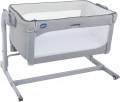Number of base levels
The number of different levels of base installation provided in the design of the crib. This height is different for different ages. So, in the first months of life, the baby is not even able to turn over independently, the risk of falling out of the crib is minimal, and therefore at this time you can set the mattress higher, so that it was more convenient to lean over to the baby. Later, when the baby is able to roll over and then sit and stand, the mattress can be lowered to minimize the risk of falling out. The more levels of
mattress depth adjustment are provided in the design, the wider the possibilities for setting its optimal height. In addition, some cribs have a removable sidewall, which allows you to move them to the parent's bed. And the adjustment of the base allows you to maximally equalize the height of the bed and crib.
End walls
The design of the end walls of the crib.
—
Slatted. As the name implies, they consist of vertical slats. The advantage of such a design is that you and your baby can see each other, hang various toys; in addition, the slats can be used as supports for the baby to sit down or stand up. On the other hand, in such cribs the baby is exposed to draft, so for slatted end walls special fabric walls are produced, which can be installed as protection.
—
Solid. Such walls do not have openings, slats, etc., and therefore do not allow you to see the baby — on the other hand, they provide the best protection against draft.
—
Slatted/solid. This may refer to two options. The first is when one wall is solid and the second is slatted or with large openings. In this way, the design combines the graceful appearance of a slatted wall with additional protection against draft. The second option — when part of the wall is made solid, and part is made in the form of slats. This design is used for aesthetic reasons, but in practical terms it does not differ from a conventional slatted wall.
—
Mesh. End walls in the form of frames covered with a fine mesh. Compared to slatted walls, such walls provide somewhat better protection against draft and at the same time allow the parent and baby to see each other. On the other h
...and, such a wall is not suitable as an additional support for a baby.Sidewalls
The type of sidewalls of the crib.
—
Slatted. They consist of vertical slats, for more details on the advantages and disadvantages of this design, refer to "Endwalls".
—
Solid. A solid surface with no recesses or holes. For more information on the advantages and disadvantages of this design, refer to "Endwalls".
—
Mesh. This wall is a frame with a mesh installed in it. It provides slightly better protection against drafts than a slatted wall; on the other hand, it is poorly suited as a support for the baby. It is used rather rarely, usually when it is difficult to install slats.
— Slatted/solid. This means that one sidewall is solid and the other is slatted. Such a crib is usually placed with a solid sidewall against the wall. Thus, parents can see the baby through the front wall, the baby can use the slats as a support for standing up, and the solid back wall protects it from drafts and contact with the wall.
— Solid/mesh. Solid walls, usually made of dense fabric, supplemented with mesh inserts. These inserts are designed to improve ventilation and to allow parents to see the baby better.
Lockable wheels
The latches are designed to
block the rotation of the wheels of the bed and prevent it from moving — for example, if a nearby baby tries to climb onto the bed or grab to stand up, the bed without latches can move, which is fraught with unpleasant consequences.
Mattress
The size of the mattress in length and width in centimeters. The standard sizes of baby mattresses are 60x120, 70x120 and 70x140; you should pay attention to these sizes if you plan to buy a mattress separately from the crib.
The length of baby cribs varies from 90 to 140 cm, with 120 cm being the most common. The smaller size means that the crib will have to be changed sooner, and the longer lengths are usually convertible cribs (refer to "Type") designed not only for babies, but also for preschoolers and schoolchildren.
The width of the mattress can vary from 40 to
70 cm, and the most common option is
60 cm, this is considered quite enough. As in the case of length, a smaller width means that the baby will become cramped in it earlier, and usually convertible models have a larger width.
All of the above does not apply to cradles (refer to "Type") — they are designed only for the smallest and are much smaller.

